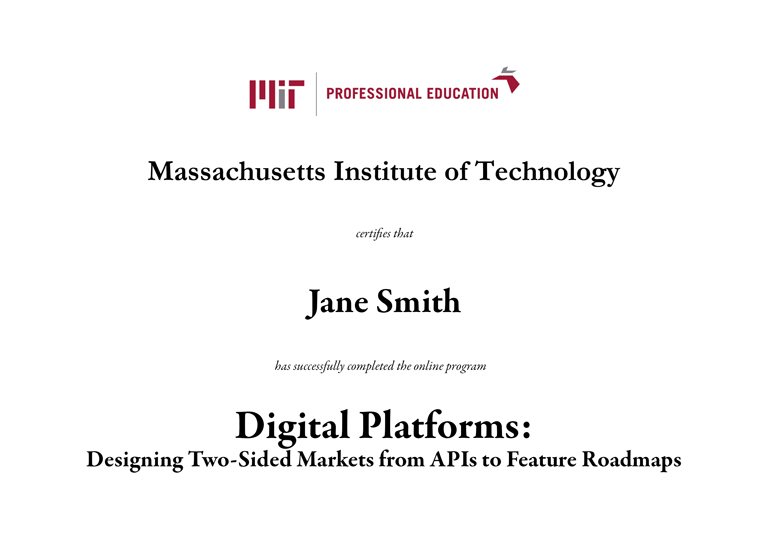Digital Platforms
Designing Two-Sided Markets from APIs to Feature Roadmaps
Digital Platforms: A Growing Business Model
Digital platforms and two-sided markets have quickly established themselves as a staple of modern business, presenting new opportunities and challenges alike for engineers, product managers, regulators, and entrepreneurs. However, there continues to be little discussion surrounding why some digital platforms help companies flourish where others have fallen short.
+40%
In 2020, the value of the world’s top 100 online platforms increased by 40%.*
*European Commission
1/5
The five largest platform companies (Alphabet, Amazon, Apple, Microsoft, and Facebook) [….] make up almost a fifth of the value of the S&P 500 Index.
Source: The Economist
x2
The sales growth of 43 innovation and transaction platforms from 1995-2015 was DOUBLE that of their non-platform peers.
Source: The Business Of Platforms: Strategy in the Age of Digital Competition, Innovation, and Power. Authors: Cusumano, Gawer, Yoffie.
An online course for developing digital platforms
MIT Professional Education’s online course Digital Platforms aims to guide participants as they design and develop effective digital platforms. This course employs a technical approach to building loyal consumer bases and differentiated products, taking an in-depth look at features, APIs and standards.
The course is designed with practicality in mind and includes several case studies of successes and failures in modern markets.
Throughout this course, participants will:
1.
Recognize two-sided markets distinguish them from traditional one-sided or direct buyer-seller markets.
2.
Critically analyze and discuss examples of industry platforms such as eBay, Etsy, Apple, Amazon, and Alibaba, and determine factors for success and failure.
3.
Identify the technical choices a firm makes in creating APIs and industry standards for two-sided markets enabled by digital platforms.
4.
Plan for development and rollout of a two-sided market, including adding features, incentivizing key customers, and negotiating with partners.
5.
Examine the most recent research and models on two-sided markets, including on the stability of two-sided markets.
6.
Define metrics for success in adoption and customer engagement.
7.
Frame the tactics for growing provider and customer bases simultaneously versus the firm’s balance sheet.
In addition, you will receive a Certificate of Completion
All the participants who successfully complete the online course Digital Platforms: Designing Two-Sided Markets from APIs to Feature Roadmaps will receive an MIT Professional Education Certificate of Completion. Furthermore, participants will receive * MIT Continuing Education Units (CEUs)*.
To obtain CEUs, complete the accreditation confirmation, which is available at the end of the course. CEUs are calculated for each course based on the number of learning hours.
* The Continuing Education Unit (CEU) is defined as 10 contact hours of ongoing learning to indicate the amount of time they have devoted to a non-credit/non-degree professional development program.
To understand whether or not these CEUs may be applied toward professional certification, licensing requirements, or other required training or continuing education hours, please consult your training department or licensing authority directly.

This course is aimed at
This course is designed for professionals that operate digital platforms or are creating a business around a digital platform and are looking to leverage these platforms to make informed decisions, differentiate their products, and grow their customer base.
The contents can be of great benefit for professionals from a number of sectors and different levels, such as:
- C-SUITE AND OTHER EXECUTIVES
looking to gain a deeper technical understanding of digital platforms in order to make more effective decisions for their organization.
- DEVELOPERS AND ENGINEERS
who work with digital platforms and want to learn about the key technical choices of two-sided markets, such as software development kits or application programming interfaces (APIs).
- PRODUCT MANAGERS
who want to leverage their technical choices for a dynamic digital platform strategy in the online marketplace.
- ENTREPRENEURS
looking to develop startups centered around digital platforms and two-sided markets and who want to ensure their company’s success in the online marketplace.
- POLICY EXPERTS AND REGULATORS
who work with digital market policies in an expanding global economy.
- PROFESSIONALS FROM TECHNICAL BACKGROUNDS
who work with digital platforms and two-sided markets who want to understand the choices they can make to enable their success.
Meet the instructors of this course
Listed in alphabetical order
DR. BRUCE CAMERON
Director, System Architecture Group
Senior Lecturer in System Design and Management
Faculty Director, Architecture and Systems Engineering Certificate

“Digital platforms are some of the most interesting (and hardest!) technical challenges to work on today”.
Learn more
Bruce Cameron is director of the System Architecture Lab at MIT and cofounder of the consulting firm Technology Strategy Partners. His areas of research include technology strategy, system architecture, and product platform management. Previously, Dr. Cameron led the MIT Commonality study, a 30-company investigation on platform performance. The study concluded that firms face systemic pressure on homogeneity, partially as a result of problems in determining costs. Dr. Cameron has supervised more than 50 graduate students and directed research projects for Amazon, BP, Sikorsky, Nokia, Caterpillar, AMGEN, Verizon, and NASA.
Bruce Cameron teaches system architecture for the System Design and Management program, where he has trained over 500 students. Dr. Cameron’s teaching at Sloan Executive Education has been tied for the highest rated Executive Education program at MIT for several years. In addition, he is the faculty director of MIT’s Architecture and System Engineering online certificate, which has taught more than 5,300 participants.
PROF. OLIVIER DE WECK
Professor of Aeronautics and Astronautics
and Engineering Systems, MIT

“Developers of two-sided market platforms must acquire enough users on both sides in appropriate proportions to generate value to either side of the user market and thereby provide the foundation for sustained future growth.”
Learn more
De Weck is a leader in systems engineering research. He focuses on how complex, man-made systems such as aircraft, spacecraft, automobiles, printers, and critical infrastructures are designed and how they evolve over time. His main emphasis is on strategic properties that have the potential to maximize lifecycle value. Since 2001 his group has developed novel quantitative methods and tools that explicitly consider manufacturability, flexibility, commonality, and sustainability among other characteristics. De Weck’s teaching emphasizes excellence, innovation, and the bridge between theory and practice.
Prof. de Weck holds a degree in industrial engineering from ETH Zurich
He also holds a degree in aerospace systems engineering from MIT
He defined and implemented Technology Planning and Roadmapping at Airbus
